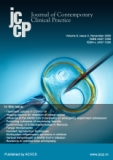Comparative analysis of breast imaging: a multi-modality approach may improve the overall quality of clinical output
Comparative analysis of breast imaging: a multi-modality approach may improve the overall quality of clinical output
Author(s): Besra Dagoglu, Deniz Esin Tekcan Sanli, Pinar Polat SumaSubject(s): Health and medicine and law, Present Times (2010 - today)
Published by: Asociația pentru Creșterea Vizibilității Cercetării Științifice (ACVCS)
Keywords: Mammography; breast cancer; breast MRI; breast ultrasound; clinical output; decision making; multi-modality diagnosis;
Summary/Abstract: Introduction This study aims to assess the efficacy of magnetic resonance imaging (MRI), mammography and ultrasound (US) in detection of breast cancer presenting as mass or non-mass lesions. Methods MRI was performed in 53 patients with a suspected breast cancer based on mammography and US features. US or mammography-guided biopsies were obtained in patients with BI-RADS category 4-5. Histopathological results were considered as the gold standard for diagnosis, and based on histopathology results, mammography and MRI characteristics of mass, non-mass benign or malign lesions were evaluated. Results A benign pathology was detected in 22 cases (41.5%) and malignant pathology in 31 cases (58.4%). The mean age was 37.3 years in patients with a benign diagnosis and 50.5 years in patients with a malignant diagnosis. Overall, 21 (68%) of the malignant cases had a mass appearance and 10 (32%) had a non-mass appearance; 90% of malignant lesions were isointense or hypointense on T2-weighted images. The positive predictive value (PPV) for malignancy was 78.2% with peripheral contrast enhancement, 88% with hypointensity on T2-weighted images and 83.3% in heterogeneous contrast enhancement. PPV for benignity was 100% with homogeneous contrast enhancement, 100% dark internal septa in the mass, and 54.5% with regional contrast enhancement. The most common type enhancement curve was type 2 with plateau detected in 20 cases out of the whole study population. Conclusions Although MRI is more sensitive in characterization of breast lesions, correlation with BIRADS category and histopathology allows more accurate clinical decisions and better outcomes by avoiding false positivity, unnecessary medical intervention and concerns. MRI findings of breast lesions should be evaluated together with mammography and ultrasonography.
Journal: Journal of Contemporary Clinical Practice
- Issue Year: 6/2020
- Issue No: 2
- Page Range: 48-57
- Page Count: 10
- Language: English

